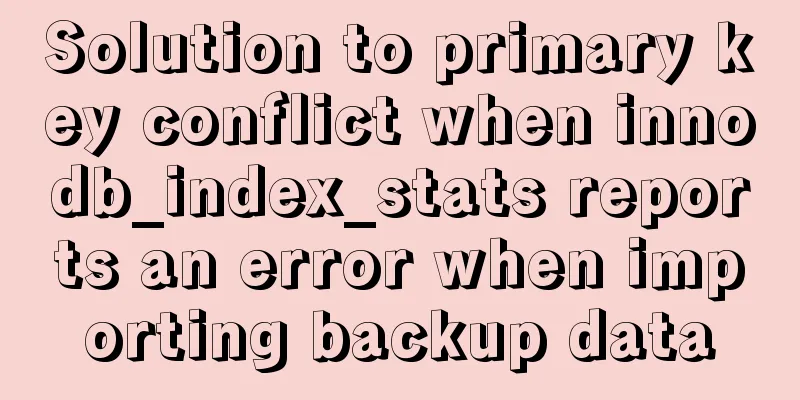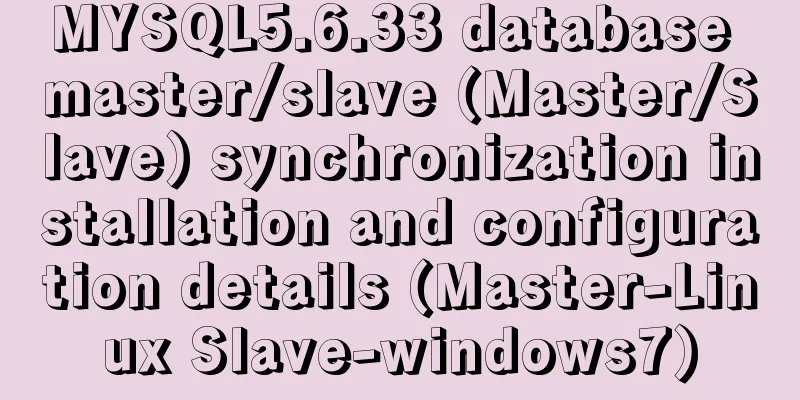A complete guide on how to query and delete duplicate records in MySQL

|
Preface This article mainly introduces the methods of querying and deleting duplicate records in MySQL. It is shared for your reference and learning. Let's take a look at the detailed introduction: Find all records with duplicate titles: select title,count(*) as count from user_table group by title having count>1; SELECT * FROM t_info a WHERE ((SELECT COUNT(*) FROM t_info WHERE Title = a.Title) > 1) ORDER BY Title DESC 1. Find duplicate records 1. Find all duplicate records SELECT * FROM t_info a WHERE ((SELECT COUNT(*) FROM t_info WHERE Title = a.Title) > 1) ORDER BY Title DESC 2. Filter duplicate records (only one is displayed) Select * From HZT Where ID In (Select Max(ID) From HZT Group By Title) Note: This shows the record with the largest ID 2. Delete duplicate records 1. Delete all duplicate records ( use with caution ) Delete table Where repeated fields In (Select repeated fields From table Group By repeated fields Having Count(*)>1) 2. Keep one (this should be what most people need^_^) Delete HZT Where ID Not In (Select Max(ID) From HZT Group By Title) Note: The record with the largest ID is retained here 3. Examples 1. Find redundant duplicate records in the table. Duplicate records are determined based on a single field (peopleId) select * from people where peopleId in (select peopleId from people group by peopleId having count(peopleId) > 1) 2. Delete redundant duplicate records in the table. Duplicate records are determined based on a single field (peopleId). Only the record with the smallest rowid is retained. delete from people where peopleId in (select peopleId from people group by peopleId having count(peopleId) > 1) and rowid not in (select min(rowid) from people group by peopleId having count(peopleId )>1) 3. Find redundant duplicate records in the table (multiple fields) select * from vitae a where (a.peopleId,a.seq) in (select peopleId,seq from vitae group by peopleId,seq having count(*) > 1) 4. Delete redundant duplicate records (multiple fields) in the table, leaving only the record with the smallest rowid delete from vitae a where (a.peopleId,a.seq) in (select peopleId,seq from vitae group by peopleId,seq having count(*) > 1) and rowid not in (select min(rowid) from vitae group by peopleId,seq having count(*)>1) 5. Find redundant duplicate records (multiple fields) in the table, excluding the record with the smallest rowid select * from vitae a where (a.peopleId,a.seq) in (select peopleId,seq from vitae group by peopleId,seq having count(*) > 1) and rowid not in (select min(rowid) from vitae group by peopleId,seq having count(*)>1) 4. Supplement There are more than two duplicate records. One is a completely duplicate record, that is, a record with all fields duplicated. The other is a record with some key fields duplicated, such as the Name field is duplicated, while other fields may not be duplicated or may be duplicated and can be ignored. 1. For the first type of repetition, it is easier to solve. Use select distinct * from tableName You can get a result set without duplicate records. If the table needs to delete duplicate records (retain only one duplicate record), you can delete it as follows: select distinct * into #Tmp from tableName drop table tableName select * into tableName from #Tmp drop table #Tmp This duplication occurs due to poor table design and can be resolved by adding a unique index column. 2. This type of duplicate problem usually requires retaining the first record of the duplicate records. The operation method is as follows Assume that there are repeated fields named Name and Address, and you want to get a unique result set for these two fields. select identity(int,1,1) as autoID, * into #Tmp from tableName select min(autoID) as autoID into #Tmp2 from #Tmp group by Name,autoID select * from #Tmp where autoID in(select autoID from #tmp2) Summarize The above is the full content of this article. I hope that the content of this article can bring some help to your study or work. If you have any questions, you can leave a message to communicate. Thank you for your support of 123WORDPRESS.COM. You may also be interested in:
|
<<: Detailed explanation of Nest.js parameter validation and custom return data format
>>: How to install git on linux
Recommend
The functions and differences between disabled and readonly
1: readonly is to lock this control so that it can...
VMware Workstation 15 Pro Installation Guide (for Beginners)
01. VMware Workstation Pro 15 Download Download: ...
Docker+K8S cluster environment construction and distributed application deployment
1. Install Docker yum install docker #Start the s...
Summary of methods for finding and deleting duplicate data in MySQL tables
Sometimes we save a lot of duplicate data in the ...
Implementing add, delete, modify and query operations on MySQL based on sqlalchemy
Demand scenario: The boss asked me to use the cra...
CocosCreator implements skill cooling effect
CocosCreator realizes skill CD effect There are s...
Detailed tutorial on building a local idea activation server
Preface The blogger uses the idea IDE. Because th...
Summary of the installation process of MySql 8.0.11 and the problems encountered when linking with Navicat
My system and software versions are as follows: S...
MySQL practical window function SQL analysis class students' test scores and living expenses
Table of contents 1. Background 2. Table creation...
Example code for implementing a QR code scanning box with CSS
We usually have a scanning box when we open the c...
Analysis of Mysql transaction characteristics and level principles
1. What is a transaction? A database transaction ...
Learn how to write neat and standard HTML tags
Good HTML code is the foundation of a beautiful w...
Implementation of one-click packaging and publishing of Vue projects using Jenkins
Table of contents Jenkins installation Install Ch...
Essential Handbook for Web Design 216 Web Safe Colors
The color presentation on a web page will be affec...









